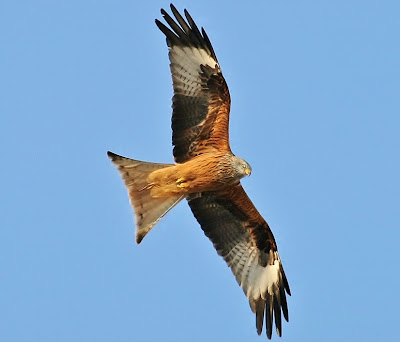Milvus milvus
 |
| Photo by Thomas Kraft (Wikipedia) |
Common name:
red kite (en); milhafre-real (pt); milan royal (fr); milano real (es); rotmilan (de)
Taxonomy:
Order Falconiformes
Family Accipitridae
Range:
The red kite is almost entirely restricted to Europe, being found from southern Sweden and the Baltic, through Poland and Germany and into France, Great Britain, Italy and the Iberian Peninsula. There is also small population in Morocco.
Size:
These birds are 60-73 cm long and have a wingspan of 150-179 cm. They weigh 800-1.300 g.
Habitat:
They are mostly found in open temperate forests, scrublands and grasslands, but are also common over pastures, agricultural areas and even inside urban areas.
Diet:
Red kites are mostly scavengers, taking a wide range of animal carrion including sheep, rabbits, birds and even waste from refuse dumps. They also hunt small animals such as reptiles, amphibians, small mammals, fishes, insects and earthworms.
Breeding:
These birds are monogamous and may pair for life. They breed in April-August and the nest is an untidy platform made of sticks and twigs and lined with wool and sometimes pieces of paper, plastic or cloth. The nest is placed in a fork in a tree, typically an oak, beech or pine, 12-20 m above the ground. The female lays 1-4 white eggs with reddish-brown spots, which she incubates alone for 32-33 days. The chicks are fed by both parents and fledge 48-54 days after hatching.
Conservation:
IUCN status - NT (Near-Threatened)
This species has a very large breeding range and the global population is estimated at 42.000-51.000 individuals. After a generalized decline until the 1970s, some populations are now increasing or stable, but further declines are being witnessed in core breeding areas such as Spain, France and Germany, so the overall population trend is still negative. The main threat to the red kite is illegal direct poisoning and indirect poisoning from pesticides and rodent bait, but other threats include habitat loss due to agricultural intensification, electrocution and collision with power lines and wind turbines, hunting and trapping, road-kills, deforestation, egg-collection and possibly competition with the generally more successful black kite M. migrans.
Beautiful flight image Pedro.
ReplyDeleteDon't congratulate me, congratulate Tomas Kraft :)
ReplyDelete